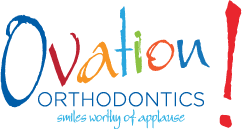FAQ
Frequently asked questions for new patients

What age is too old to get treatment?
Healthy teeth can be moved at any age. Members of the American Association of Orthodontists (AAO) regularly treat adult patients. At Ovation Orthodontics, about one in three of our patients are adults, with many in their 50s, 60s, 70s, and even 80s. Depending on your circumstances, your orthodontist may work with your primary care dentist and other dental specialists to help you achieve optimal dental health.
Can I use my insurance to cover orthodontic treatment?
Many people have dental insurance that includes orthodontic benefits, typically provided by their employer. Such insurance covers a portion or percentage of the fee for orthodontic treatment, and many times, there may be a specific dollar amount or lifetime cap. If your dental insurance is through your employer, your human resources department may be able to provide coverage details. You can also obtain the information directly from the insurance company. With your permission, Ovation Orthodontics can confirm your insurance benefits for you.
Can a deep bite correct itself over time?
Deep bites typically do not resolve on their own, and if left untreated, they can worsen and lead to further orthodontic issues. Factors such as tooth wear or habits like teeth grinding can sometimes exacerbate the condition in adults.
How long do retainers need to be worn?
Typically, a retainer is necessary for a lifetime, though the frequency of wear may decrease over time. Retainers are prescribed for two reasons: first, to allow the bone that holds teeth to rebuild after teeth have moved, and second, to maintain the healthy new positions of teeth after active orthodontic treatment ends. Your body changes your whole life, and your teeth change too. The only way to keep your teeth in the ideal position created by your orthodontic treatment is to wear retainers for life!
What is the difference between a deep bite and an overbite?
“Deep bite” and “overbite” are often used interchangeably to describe a malocclusion where the upper front teeth significantly cover the lower front teeth vertically. This is often confused with an overjet, which refers to the horizontal distance between the upper and lower front teeth. Commonly known as “buck teeth,” overjet occurs when the upper front teeth extend forward at an angle, whereas an overbite or deep bite occurs when the upper front teeth vertically cover the bottom front teeth.
Should my child wait until they have all of their permanent teeth to see an orthodontist?
No. Waiting until all the permanent teeth have come in, or until facial growth is nearly complete, could make correction of some orthodontic problems more difficult. Some issues cannot be addressed once the face and jaws are no longer growing.
What age is appropriate to start orthodontic treatment?
It is recommended by the AAO (American Association of Orthodontists) that a child be seen at age 7 by an orthodontist.
Howeber, Orthodontic treatment can begin at various ages, depending on the individual’s dental needs. Here’s a general guideline:
Early Childhood (Ages 7-10):
The American Association of Orthodontists recommends that children have their first orthodontic evaluation by age 7. At this age, our doctors can identify potential issues with jaw growth and emerging teeth. Early treatment, also known as Phase I treatment, can help guide the growth of the jaw and the eruption of permanent teeth, potentially preventing more severe problems later.Pre-Teens and Teens (Ages 11-18):
This is the most common age range for orthodontic treatment. By this time, most or all of the permanent teeth have erupted, and the jaw is still growing, making it an ideal time for braces or aligners. Treatment during these years can address alignment, bite, and spacing issues effectively.Adults:
Orthodontic treatment isn’t just for kids and teens. Many adults seek orthodontic care to correct long-standing issues or to improve their smile and oral health. Modern treatment options like Invisalign® or clear braces make orthodontic care more discreet and convenient for adults.
What are the benefits of orthodontic treatment?
Orthodontic treatment offers numerous benefits, both cosmetic and health-related. Here are some of the key advantages:
Improved Aesthetics:
- Enhanced Smile: Orthodontic treatment straightens teeth, closes gaps, and corrects alignment, resulting in a more attractive smile.
- Boosted Confidence: A better smile can significantly increase self-esteem and confidence in social and professional situations.
Better Oral Health:
- Easier Cleaning: Straight teeth are easier to brush and floss, reducing the risk of tooth decay, gum disease, and other oral health issues.
- Reduced Wear and Tear: Proper alignment of teeth prevents uneven wear and tear on enamel, which can lead to damage over time.
Improved Functionality:
- Corrected Bite: Orthodontic treatment can correct bite issues such as overbite, underbite, crossbite, and open bite, leading to better chewing and speaking abilities.
- Jaw Alignment: Proper alignment of the jaw can alleviate issues such as jaw pain, TMJ disorders, and headaches caused by misalignment.
What complications can arise from an untreated crossbite?
If overlooked, crossbites can trigger jaw misalignment, uneven jaw growth, premature wearing of the tooth enamel, facial asymmetry, and improper chewing, among other dental issues.
What happens if orthodontic problems are not treated?
Generally, untreated orthodontic problems may worsen. Lack of orthodontic treatment can contribute to tooth decay, gum disease, destruction of the bone that holds teeth in place, tooth loss, chewing/digestive difficulties, or abnormal wearing away of tooth enamel. Ultimately, orthodontic treatment may cost less than the restorative treatment that could be needed to treat decayed, worn, or lost teeth, or gum disease.
What types of orthodontic treatments do you offer?
We offer a range of orthodontic treatments tailored to meet your specific needs:
- Traditional Braces: Effective for correcting various dental misalignments using metal or ceramic brackets and wires.
- Clear Aligners: Virtually invisible aligners that gradually shift teeth into alignment, offering a discreet orthodontic option.
- Functional Appliances: Devices used to address jaw discrepancies and improve bite function in growing patients.
- Retainers: Custom-made appliances to maintain teeth alignment post-treatment and prevent relapse.
Will I have to have teeth extracted?
At Ovation Orthodontics, we take a conservative approach to removing teeth. However, in some cases, extractions may be necessary to achieve the best result. Whether extractions are required depends on several factors, including the severity of crowding, jaw size, bite alignment, and treatment goals. Alternative techniques like dental arch expansion or interproximal reduction may also be considered to minimize the need for extractions.
Will my child’s teeth get straighter as they age?
It’s a common misconception that a child’s teeth will straighten on their own as they age. In fact, teeth are more likely to become more crowded or misaligned over time due to natural growth patterns, eruption of larger permanent teeth, oral habits, and wisdom teeth coming in. Early orthodontic intervention can guide jaw growth and the eruption of teeth, helping prevent misalignment issues later on.
